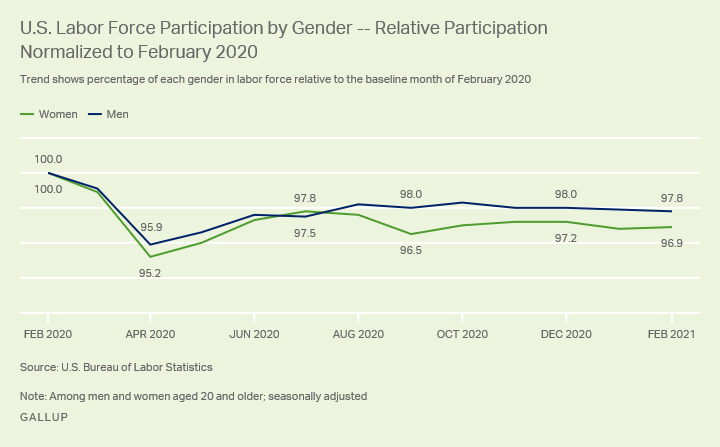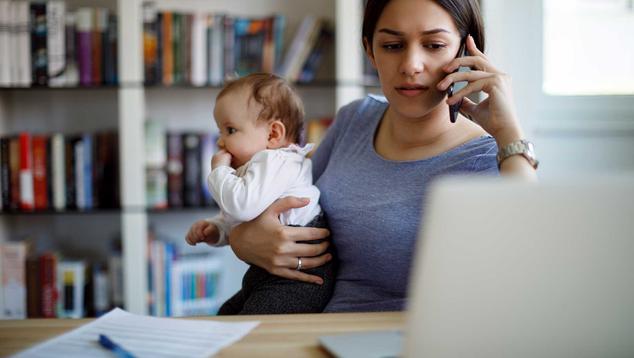Story Highlights
- Women have outpaced men in leaving the workforce since COVID-19
- Job type and child care needs are playing a large role in women's departure
- Women have been more likely than men to enter retirement during the pandemic
This is Part 1 of a two-part series on the impact of the COVID-19 pandemic on working women. Part 2 focuses on the psychological toll the pandemic has had.
WASHINGTON, D.C. -- Job losses related to the COVID-19 pandemic have hit women harder than men, starting with the pandemic in early 2020 and continuing one year later through February 2021. Monitoring the extent of that gender gap and understanding the reasons for it will ultimately help businesses and policymakers craft solutions that correct the gap as quickly as possible.
This analysis is meant to advance that understanding using U.S. Bureau of Labor Statistics (BLS) employment trends from February 2020 through February 2021, as well as Gallup and U.S. Census Bureau data on the factors influencing women's workforce participation.
The Jobs Story
The chart below displays the relative percentages of men and women in the U.S. labor force each month from February 2020 to February 2021, based on data from the BLS Current Population Survey (CPS). For this analysis, the numbers of women and men in the workforce in February 2020 are considered 100% participation, with all subsequent percentages signifying labor force participation relative to that baseline.
This clearly shows how labor force participation -- defined as all civilians working full or part time, as well as those who are unemployed but looking for work -- fell dramatically for both genders between March and April 2020, as business and school closures occurred.
The initial decline was slightly larger for women than men (about 5% vs. 4%, respectively), but female participation caught back up with male participation over the summer -- before dropping again, disproportionately, in the fall. Since September, a gender gap of about one percentage point has persisted, and little progress has been made in restoring pre-COVID employment levels.

Line graph. Monthly trend from February 2020 to February 2021 in the percentage of women and men aged 20 and older who are in the U.S. labor force relative to the baseline month of February 2020. For each gender, employment is considered 100% in February 2020. It declined sharply to between 95.2% and 95.9% for each in April, after which it rose to over 97% in July and has since varied around that level. Based on seasonally adjusted Bureau of Labor Statistics data for the number of men and women in the U.S. labor force.
As a result of these changes, as of February 2021, the female labor force is 3.1% smaller than a year earlier, and the male labor force is 2.2% smaller. This gap is reflected in the BLS labor force participation rate, which fell by 2.2 percentage points for women and 2.0 points for men.1
The gap in labor force changes amounts to roughly 493,000 more women than men being absent from the labor force since the pandemic began. This is the difference between the roughly 2.3 million women missing from the U.S. workforce as of February 2021, compared with about 1.8 million men.
| February 2020 | February 2021 | Change | ||||||||||||||||||||||||||||||||||||||||||||||||||||||||||||||||||||||||||||||||||||||||||||||||||
|---|---|---|---|---|---|---|---|---|---|---|---|---|---|---|---|---|---|---|---|---|---|---|---|---|---|---|---|---|---|---|---|---|---|---|---|---|---|---|---|---|---|---|---|---|---|---|---|---|---|---|---|---|---|---|---|---|---|---|---|---|---|---|---|---|---|---|---|---|---|---|---|---|---|---|---|---|---|---|---|---|---|---|---|---|---|---|---|---|---|---|---|---|---|---|---|---|---|---|---|---|
| Number in labor force | ||||||||||||||||||||||||||||||||||||||||||||||||||||||||||||||||||||||||||||||||||||||||||||||||||||
| Women, 20 and older | 74,501,000 | 72,173,000 | -2,328,000 | |||||||||||||||||||||||||||||||||||||||||||||||||||||||||||||||||||||||||||||||||||||||||||||||||
| Men, 20 and older | 83,930,000 | 82,095,000 | -1,835,000 | |||||||||||||||||||||||||||||||||||||||||||||||||||||||||||||||||||||||||||||||||||||||||||||||||
| Difference (net women) | -9,429,000 | -9,922,000 | -493,000 | |||||||||||||||||||||||||||||||||||||||||||||||||||||||||||||||||||||||||||||||||||||||||||||||||
| Percentage in labor force | ||||||||||||||||||||||||||||||||||||||||||||||||||||||||||||||||||||||||||||||||||||||||||||||||||||
| Women, 20 and older | 59.2% | 57.0% | -2.2 points | |||||||||||||||||||||||||||||||||||||||||||||||||||||||||||||||||||||||||||||||||||||||||||||||||
| Men, 20 and older | 71.6% | 69.6% | -2.0 points | |||||||||||||||||||||||||||||||||||||||||||||||||||||||||||||||||||||||||||||||||||||||||||||||||
| Difference (net women) | -12.4 points | -12.6 points | -0.2 points | |||||||||||||||||||||||||||||||||||||||||||||||||||||||||||||||||||||||||||||||||||||||||||||||||
| Source: U.S. Bureau of Labor Statistics Note: Numbers of men and women in the workforce are rounded to the nearest thousand. |
||||||||||||||||||||||||||||||||||||||||||||||||||||||||||||||||||||||||||||||||||||||||||||||||||||
| Gallup | ||||||||||||||||||||||||||||||||||||||||||||||||||||||||||||||||||||||||||||||||||||||||||||||||||||
When it comes to unemployment -- which refers to people in the labor force who are not working but are either actively seeking work or waiting to be recalled from temporary layoff -- the opposite pattern has emerged.
The number of unemployed workers has increased by about 2.2 million men and 1.9 million women since February 2020. Thus, when including declines in labor force participation, overall job losses have been similar between genders (4.0 million total losses for men aged 20 and over, compared with 4.2 million total losses for women) -- but women have been more likely to leave the labor force, while men continue to actively seek employment or wait to be recalled from temporary layoff.
| February 2020 | February 2021 | Change | ||||||||||||||||||||||||||||||||||||||||||||||||||||||||||||||||||||||||||||||||||||||||||||||||||
|---|---|---|---|---|---|---|---|---|---|---|---|---|---|---|---|---|---|---|---|---|---|---|---|---|---|---|---|---|---|---|---|---|---|---|---|---|---|---|---|---|---|---|---|---|---|---|---|---|---|---|---|---|---|---|---|---|---|---|---|---|---|---|---|---|---|---|---|---|---|---|---|---|---|---|---|---|---|---|---|---|---|---|---|---|---|---|---|---|---|---|---|---|---|---|---|---|---|---|---|---|
| Number employed | ||||||||||||||||||||||||||||||||||||||||||||||||||||||||||||||||||||||||||||||||||||||||||||||||||||
| Women, 20 and older | 72,171,000 | 67,928,000 | -4,243,000 | |||||||||||||||||||||||||||||||||||||||||||||||||||||||||||||||||||||||||||||||||||||||||||||||||
| Men, 20 and older | 81,235,000 | 77,193,000 | -4,042,000 | |||||||||||||||||||||||||||||||||||||||||||||||||||||||||||||||||||||||||||||||||||||||||||||||||
| Difference (net women) | -9,064,000 | -9,265,000 | -201,000 | |||||||||||||||||||||||||||||||||||||||||||||||||||||||||||||||||||||||||||||||||||||||||||||||||
| Number unemployed | ||||||||||||||||||||||||||||||||||||||||||||||||||||||||||||||||||||||||||||||||||||||||||||||||||||
| Women, 20 and older | 2,330,000 | 4,245,000 | +1,915,000 | |||||||||||||||||||||||||||||||||||||||||||||||||||||||||||||||||||||||||||||||||||||||||||||||||
| Men, 20 and older | 2,695,000 | 4,902,000 | +2,207,000 | |||||||||||||||||||||||||||||||||||||||||||||||||||||||||||||||||||||||||||||||||||||||||||||||||
| Difference (net women) | -365,000 | -657,000 | -292,000 | |||||||||||||||||||||||||||||||||||||||||||||||||||||||||||||||||||||||||||||||||||||||||||||||||
| Unemployment rate | ||||||||||||||||||||||||||||||||||||||||||||||||||||||||||||||||||||||||||||||||||||||||||||||||||||
| Women, 20 and older | 3.1% | 5.9% | +2.8 points | |||||||||||||||||||||||||||||||||||||||||||||||||||||||||||||||||||||||||||||||||||||||||||||||||
| Men, 20 and older | 3.2% | 6.0% | +2.8 points | |||||||||||||||||||||||||||||||||||||||||||||||||||||||||||||||||||||||||||||||||||||||||||||||||
| Difference (net women) | -0.1 points | -0.1 points | 0.0 points | |||||||||||||||||||||||||||||||||||||||||||||||||||||||||||||||||||||||||||||||||||||||||||||||||
| Source: U.S. Bureau of Labor Statistics Note: Numbers of employed men and women are rounded to the nearest thousand. |
||||||||||||||||||||||||||||||||||||||||||||||||||||||||||||||||||||||||||||||||||||||||||||||||||||
| Gallup | ||||||||||||||||||||||||||||||||||||||||||||||||||||||||||||||||||||||||||||||||||||||||||||||||||||
What Explains the Gender Disparity in Workforce Participation?
Several factors could explain why more women than men have left the labor force, chiefly:
- the types of jobs women tend to have were disproportionately affected by the economic slowdown and shutdowns of the past year compared with the types of jobs men tend to have
- greater family demands on women than on men, related to child care and school closures
- women's greater fear of contracting COVID-19 combined with overrepresentation of women in jobs that risk greater exposure to the virus
The Gallup analysis presented below indicates that occupation-based factors have been the most important, followed by gender differences in child care roles. Women's greater fear of contracting the illness does not appear to be a significant factor, perhaps because of the high percentage of U.S. workers still able to work remotely.
Female-Oriented Jobs Have Fared Worse Than Male-Oriented Jobs
Among adults aged 25 to 55, prime parenting years, the participation rate declined by 2.3 percentage points between February 2020 and January 2021 among women with school-aged children. This is significantly greater than the 1.7-point decline among women with no children in this age range and the 0.8-point decline among men with children.2
| Women, with children | Women, no children | Men, with children | Men, no children | ||||||||||||||||||||||||||||||||||||||||||||||||||||||||||||||||||||||||||||||||||||||||||||||||
|---|---|---|---|---|---|---|---|---|---|---|---|---|---|---|---|---|---|---|---|---|---|---|---|---|---|---|---|---|---|---|---|---|---|---|---|---|---|---|---|---|---|---|---|---|---|---|---|---|---|---|---|---|---|---|---|---|---|---|---|---|---|---|---|---|---|---|---|---|---|---|---|---|---|---|---|---|---|---|---|---|---|---|---|---|---|---|---|---|---|---|---|---|---|---|---|---|---|---|---|
| % | % | % | % | ||||||||||||||||||||||||||||||||||||||||||||||||||||||||||||||||||||||||||||||||||||||||||||||||
| February 2020 | 74.7 | 78.4 | 93.5 | 86.5 | |||||||||||||||||||||||||||||||||||||||||||||||||||||||||||||||||||||||||||||||||||||||||||||||
| January 2021 | 72.4 | 76.7 | 92.7 | 84.8 | |||||||||||||||||||||||||||||||||||||||||||||||||||||||||||||||||||||||||||||||||||||||||||||||
| Change | -2.3 points | -1.7 points | -0.8 points | -1.7 points | |||||||||||||||||||||||||||||||||||||||||||||||||||||||||||||||||||||||||||||||||||||||||||||||
| Source: IPUMS USA, University of Minnesota | |||||||||||||||||||||||||||||||||||||||||||||||||||||||||||||||||||||||||||||||||||||||||||||||||||
| GALLUP | |||||||||||||||||||||||||||||||||||||||||||||||||||||||||||||||||||||||||||||||||||||||||||||||||||
On a preliminary basis, the 1.5-percentage-point gap in the change figures for women with children versus men with children is consistent with the theory that working mothers disproportionately took themselves out of the labor force to care for children who were no longer able to attend day care or school.
Still, while women with children show the largest workforce participation decline, the drops among women without children and men without children are also sizable. This suggests that factors other than child care have significantly influenced decisions to leave the workforce.
Overall, these labor force patterns seem largely tied to occupational differences between women and men. Occupations with a higher share of women have exhibited lower labor force participation rates and higher unemployment rates throughout the pandemic, according to Gallup's analysis of the CPS data.
Both genders are associated with occupations that have been decimated by COVID-19-related economic disruption. But, according to Gallup's analysis of the 2019 American Community Survey, women are overrepresented in occupations that have seen the largest spikes in unemployment: personal care and service, as well as food preparation and serving. Moreover, women are underrepresented in occupations that have been largely spared from layoffs, including production, computers, engineering and management.
| Share of female workers | Increase in unemployment rate | |||||||||||||||||||||||||||||||||||||||||||||||||||||||||||||||||||||||||||||||||||||||||||||||||||
|---|---|---|---|---|---|---|---|---|---|---|---|---|---|---|---|---|---|---|---|---|---|---|---|---|---|---|---|---|---|---|---|---|---|---|---|---|---|---|---|---|---|---|---|---|---|---|---|---|---|---|---|---|---|---|---|---|---|---|---|---|---|---|---|---|---|---|---|---|---|---|---|---|---|---|---|---|---|---|---|---|---|---|---|---|---|---|---|---|---|---|---|---|---|---|---|---|---|---|---|---|
| % | pct. pts. | |||||||||||||||||||||||||||||||||||||||||||||||||||||||||||||||||||||||||||||||||||||||||||||||||||
| OCCUPATIONS MOST OVERREPRESENTED BY WOMEN | ||||||||||||||||||||||||||||||||||||||||||||||||||||||||||||||||||||||||||||||||||||||||||||||||||||
| Healthcare support | 86 | +3.9 | ||||||||||||||||||||||||||||||||||||||||||||||||||||||||||||||||||||||||||||||||||||||||||||||||||
| Personal care and service | 75 | +10.7 | ||||||||||||||||||||||||||||||||||||||||||||||||||||||||||||||||||||||||||||||||||||||||||||||||||
| Office and administrative support | 75 | +2.2 | ||||||||||||||||||||||||||||||||||||||||||||||||||||||||||||||||||||||||||||||||||||||||||||||||||
| Healthcare practitioners and technical | 75 | +0.6 | ||||||||||||||||||||||||||||||||||||||||||||||||||||||||||||||||||||||||||||||||||||||||||||||||||
| Educational instruction and library | 74 | +1.0 | ||||||||||||||||||||||||||||||||||||||||||||||||||||||||||||||||||||||||||||||||||||||||||||||||||
| Community and social service | 66 | +2.1 | ||||||||||||||||||||||||||||||||||||||||||||||||||||||||||||||||||||||||||||||||||||||||||||||||||
| Food preparation and serving | 55 | +10.8 | ||||||||||||||||||||||||||||||||||||||||||||||||||||||||||||||||||||||||||||||||||||||||||||||||||
| OCCUPATIONS MOST OVERREPRESENTED BY MEN | ||||||||||||||||||||||||||||||||||||||||||||||||||||||||||||||||||||||||||||||||||||||||||||||||||||
| Management | 42 | +1.4 | ||||||||||||||||||||||||||||||||||||||||||||||||||||||||||||||||||||||||||||||||||||||||||||||||||
| Production | 31 | +1.5 | ||||||||||||||||||||||||||||||||||||||||||||||||||||||||||||||||||||||||||||||||||||||||||||||||||
| Farming, fishing and forestry | 28 | -3.9 | ||||||||||||||||||||||||||||||||||||||||||||||||||||||||||||||||||||||||||||||||||||||||||||||||||
| Computers and mathematics | 27 | +0.5 | ||||||||||||||||||||||||||||||||||||||||||||||||||||||||||||||||||||||||||||||||||||||||||||||||||
| Protective service | 24 | +1.8 | ||||||||||||||||||||||||||||||||||||||||||||||||||||||||||||||||||||||||||||||||||||||||||||||||||
| Transportation and material moving | 21 | +3.4 | ||||||||||||||||||||||||||||||||||||||||||||||||||||||||||||||||||||||||||||||||||||||||||||||||||
| Architecture and engineering | 17 | +0.4 | ||||||||||||||||||||||||||||||||||||||||||||||||||||||||||||||||||||||||||||||||||||||||||||||||||
| Military | 14 | n/a | ||||||||||||||||||||||||||||||||||||||||||||||||||||||||||||||||||||||||||||||||||||||||||||||||||
| Installation, maintenance and repair | 4 | +8.3 | ||||||||||||||||||||||||||||||||||||||||||||||||||||||||||||||||||||||||||||||||||||||||||||||||||
| Construction and extraction | 4 | +5.5 | ||||||||||||||||||||||||||||||||||||||||||||||||||||||||||||||||||||||||||||||||||||||||||||||||||
| Source: IPUMS USA, University of Minnesota | ||||||||||||||||||||||||||||||||||||||||||||||||||||||||||||||||||||||||||||||||||||||||||||||||||||
| Gallup | ||||||||||||||||||||||||||||||||||||||||||||||||||||||||||||||||||||||||||||||||||||||||||||||||||||
Importantly, women also made up 78% of workers in all healthcare occupations, combined, in 2019, amounting to more than 17 million female healthcare workers. This has made female workers far more vulnerable to exposure to COVID-19, since healthcare workers are most likely to be at risk, according to available data. While this may have contributed to more voluntary departures from the workforce by women than men because of health concerns, additional data discussed below argue against this theory.
Having Children Contributes to Slip in Workforce Participation
When accounting for occupation in a model predicting workforce participation, women with children are still at greater risk of nonparticipation than women without children or men with children. However, the effect on the gender gap in workforce participation explained by having children shrinks from 1.5 percentage points without accounting for occupation to 0.3 points when doing so.
This means occupational effects -- either alone or in combination with different gender responsibilities -- explain 80% of working mothers' greater job loss than men's during the pandemic for the population aged 25 to 55.
Occupational effects do not rule out gender effects. It could be, for example, that many women who work as female cooks were inclined to leave the labor force if they have children at home, whereas male cooks did not feel the same pressure and were more likely to stay in the labor force. By contrast, female scientists may have been just as likely as male scientists to continue working -- though remotely -- during the pandemic, regardless of whether they had children at home.
This type of pattern would show up as an occupational effect and is consistent with our results. If women tend to work in occupations with a high risk of labor force departure during COVID-19, as we found, the underlying reason could still be related to child care or other factors.
Since April, the U.S. Census Bureau Household Pulse Survey has asked a large sample of U.S. adults who are out of work what the main reason is. Looking at data from both early in the pandemic (April) and recently (January), women have been far more likely than men to cite the need to provide child care for children out of school. Twenty-three percent of women with children enrolled in school gave this response in April, and 28% in January -- compared with 11% and 12% of men with children enrolled in school, respectively. When applied to all adult women, 8% of those not working cite caring for children out of school or day care, compared with 3% of adult men.
When put in context with the disproportionate increase in nonworking women, this is strong evidence that many women have left work (and left the labor force altogether) because of child care responsibilities, and this explains a substantial portion of the gap between women and men, who are less likely to have left work for reasons related to child care.
Child care doesn't explain the entirety of the gender gap. But the Census Bureau evidence is broadly consistent with our finding that COVID-related child care responsibilities explain roughly 20% of the drop in labor force participation among women, whereas economic and health-related factors combined are playing a larger role. For example, in January, 23% of women aged 25 to 55 with children enrolled in school gave an economic reason for why they were not working (e.g., employer experienced a reduction in business), 14% gave a personal health reason, 5% indicated they were concerned about getting or spreading the virus, and 22% indicated none of the above.
Relative to the start of the pandemic, men and women are less likely to be out of work for economic reasons and more likely to be out of work for health or miscellaneous reasons that are not readily classified. Women are somewhat less likely than men to respond that fear of getting or spreading COVID-19 is a reason they are not working.
Moreover, both men and women were more likely in early 2021 than in April/May 2020 to cite retirement as a reason they are not working, suggesting that COVID-19 pushed a large number of working adults into retirement. Here too, there has been a gender gap. Household Pulse Survey data show that in January of this year, 37% of women said they were not working because of retirement, up from 31% in April 2020. For men, the rise was smaller (from 32% to 36%).
The CPS data also suggest that women have been more likely to take retirement during COVID than men. The labor force gender gap described above (showing that 493,000 more women than men left the labor force) shrinks by about 40% to 293,000 if the population is restricted to adults aged 20 to 64, because women aged 65 and older saw a larger drop in labor force participation than men.
| Women, with children (25-55) | Men, with children (25-55) | Women (all ages) | Men (all ages) | |||||||||||||||||||||||||||||||||||||||||||||||||||||||||||||||||||||||||||||||||||||||||||||||||
|---|---|---|---|---|---|---|---|---|---|---|---|---|---|---|---|---|---|---|---|---|---|---|---|---|---|---|---|---|---|---|---|---|---|---|---|---|---|---|---|---|---|---|---|---|---|---|---|---|---|---|---|---|---|---|---|---|---|---|---|---|---|---|---|---|---|---|---|---|---|---|---|---|---|---|---|---|---|---|---|---|---|---|---|---|---|---|---|---|---|---|---|---|---|---|---|---|---|---|---|---|
| % | % | % | % | |||||||||||||||||||||||||||||||||||||||||||||||||||||||||||||||||||||||||||||||||||||||||||||||||
| Jan 6-18, 2021 | ||||||||||||||||||||||||||||||||||||||||||||||||||||||||||||||||||||||||||||||||||||||||||||||||||||
| Care for children out of school/day care | 28 | 12 | 8 | 3 | ||||||||||||||||||||||||||||||||||||||||||||||||||||||||||||||||||||||||||||||||||||||||||||||||
| Economic reason | 23 | 36 | 16 | 22 | ||||||||||||||||||||||||||||||||||||||||||||||||||||||||||||||||||||||||||||||||||||||||||||||||
| Other, not listed | 22 | 19 | 17 | 15 | ||||||||||||||||||||||||||||||||||||||||||||||||||||||||||||||||||||||||||||||||||||||||||||||||
| Personal health reason | 14 | 20 | 10 | 11 | ||||||||||||||||||||||||||||||||||||||||||||||||||||||||||||||||||||||||||||||||||||||||||||||||
| Concern for getting/spreading COVID | 5 | 6 | 4 | 7 | ||||||||||||||||||||||||||||||||||||||||||||||||||||||||||||||||||||||||||||||||||||||||||||||||
| Care for elderly/person with COVID | 3 | 3 | 3 | 2 | ||||||||||||||||||||||||||||||||||||||||||||||||||||||||||||||||||||||||||||||||||||||||||||||||
| Retired | 1 | 2 | 37 | 36 | ||||||||||||||||||||||||||||||||||||||||||||||||||||||||||||||||||||||||||||||||||||||||||||||||
| Apr 23-May 5, 2020 | ||||||||||||||||||||||||||||||||||||||||||||||||||||||||||||||||||||||||||||||||||||||||||||||||||||
| Economic reason | 47 | 62 | 37 | 44 | ||||||||||||||||||||||||||||||||||||||||||||||||||||||||||||||||||||||||||||||||||||||||||||||||
| Care for children out of school/day care | 23 | 11 | 8 | 2 | ||||||||||||||||||||||||||||||||||||||||||||||||||||||||||||||||||||||||||||||||||||||||||||||||
| Other, not listed | 16 | 13 | 12 | 10 | ||||||||||||||||||||||||||||||||||||||||||||||||||||||||||||||||||||||||||||||||||||||||||||||||
| Personal health reason | 7 | 8 | 7 | 6 | ||||||||||||||||||||||||||||||||||||||||||||||||||||||||||||||||||||||||||||||||||||||||||||||||
| Care for elderly/person with COVID | 1 | 2 | 2 | 1 | ||||||||||||||||||||||||||||||||||||||||||||||||||||||||||||||||||||||||||||||||||||||||||||||||
| Retired | 1 | 1 | 31 | 32 | ||||||||||||||||||||||||||||||||||||||||||||||||||||||||||||||||||||||||||||||||||||||||||||||||
| Concern for getting/spreading COVID | -- | -- | -- | -- | ||||||||||||||||||||||||||||||||||||||||||||||||||||||||||||||||||||||||||||||||||||||||||||||||
| Source: U.S. Census Bureau Household Pulse Survey, Weeks 1 and 22. Items asked for main reason for not working for pay or profit. Economic and personal health responses were regrouped into the larger categories shown. Concerns about getting or spreading COVID not recorded in April-May data collection. | ||||||||||||||||||||||||||||||||||||||||||||||||||||||||||||||||||||||||||||||||||||||||||||||||||||
| Gallup | ||||||||||||||||||||||||||||||||||||||||||||||||||||||||||||||||||||||||||||||||||||||||||||||||||||
When these Census Bureau figures are combined with BLS data on the population out of the labor force, it suggests that 1.1 million men and 4.8 million women are currently not working because of child care reasons, but many of these people were not working before the pandemic.
Looking at only changes in the nonworking population, these data suggest that 124,000 men and 406,000 women stopped working as a result of school or day care closures. This, however, assumes that reasons given for not working are similar among all nonworking people to those who recently left the labor force, which the Census Bureau data cannot identify.
Notably, before the pandemic, Gallup found that in households with a female and male parent, the mother (50%) was much more likely than the father (7%) to be the parent most likely to care for their children on a daily basis, while another 42% reported the parents were equally involved. This pattern was also the case in households where both parents work, helping to explain why mothers have assumed a disproportionate share of the extra child care duties thrust on families by the pandemic.
Fear of COVID-19 Does Not Explain Women's Absence
Throughout the pandemic, women have expressed greater concern than men about contracting the coronavirus. On average from March 2020 through February 2021, Gallup Panel data show that a solid majority of women (62%) versus less than half of men (46%) said they were very or somewhat worried about this.
This gender difference is also seen in the workplace context, as 54% of employed women versus 41% of employed men have described themselves as very or moderately concerned about being exposed to the coronavirus at their place of work. Additionally, 66% of women versus 54% of men have reported that they are working remotely specifically to avoid being exposed to the coronavirus.
Yet, as mentioned previously, data from the Census Bureau Household Pulse Survey suggest women are slightly less likely than men to have stopped working because of greater concern about contracting COVID-19 or spreading it to others.
Analyzing five administrations of the survey (Weeks 8, 12, 16, 20 and 22) shows that 1.7% of all adult men compared with 1.4% of all adult women say they are not working because of concerns about getting or spreading COVID-19. Thus, it does not appear that fear of COVID-19 explains any of the gender gap in labor force participation trends.
Bottom Line
Despite better-than-expected job market gains last month, women are still lagging men in the jobs recovery. One concern is that many of the women who left the U.S. labor force have not merely stopped looking for a job, but now describe themselves as retired. This contrasts with men who are more likely to be taking a pause in their job quest. These will be important trends to monitor during the recovery to grasp the long-term impact the pandemic has had on women's presence in the workforce.
Separately, it's important to be clear about what has caused women to leave the workforce. The data point to two primary factors. The types of jobs women tend to hold are the chief reason, but child care is a significant secondary one.
What is the outlook for women on both scores?
- The reopening of schools is inevitable, but the reentry of working parents who stepped out to care for children is not. Employers could help by ensuring that job openings and support exist for these women and men in the post-pandemic economy.
- In terms of female-oriented occupations coming back in full force, it remains to be seen whether the patterns of behavior that businesses and individuals have settled into over the past year will lead to long-term contraction in the industries female workers depend on. Here, the February jobs report provides some encouragement in the larger-than-average gains reported in leisure and hospitality as well as other services. But there remains a long road ahead for full recovery in these sectors.
This is Part 1 of a two-part series on the impact of the COVID-19 pandemic on working women. Part 2, releasing later this month, will focus on women's personal wellbeing.
Learn more about how the Gallup Panel works.
Footnotes
[1] That gap of 0.2 percentage points for the BLS figures is smaller than the 0.9-point gap seen in the chart because women are more numerous than men (by 7.3%), so it requires a larger change in labor force participation to affect the female participation rate.
[2] To assess significance, we calculated the standard errors of each change and compared them in a t-test using STATA. Changes for both women without children and men with children were significantly smaller than that for women with children. Going further, we included various control variables -- most notably, age. We ran a regression model to predict labor force participation controlling for age, whether the respondent is a woman (a gender effect, irrespective of COVID or child care), whether the time is during the COVID-19 era (March 2020 and on), whether the respondent has a school-aged child (a parenting effect), whether the respondent has a child during the COVID-19 era (a COVID/parenting effect), and whether the respondent is a woman with a child (a gender/parenting effect unrelated to COVID). Finally, the main variable of interest is whether the respondent is a woman with a child during COVID, which tells us whether parenting during COVID has effects that vary by gender. Data are from IPUMS-CPS, University of Minnesota.





